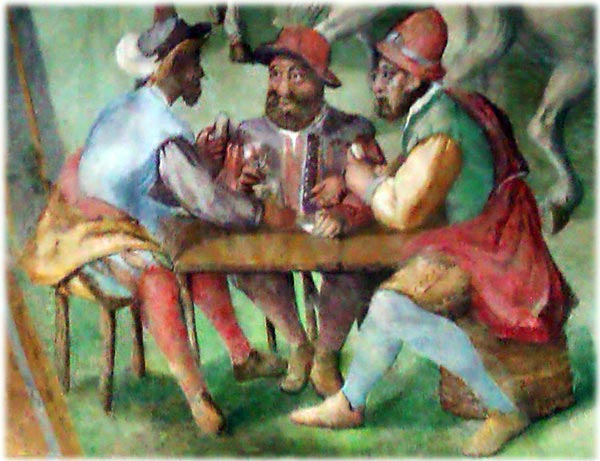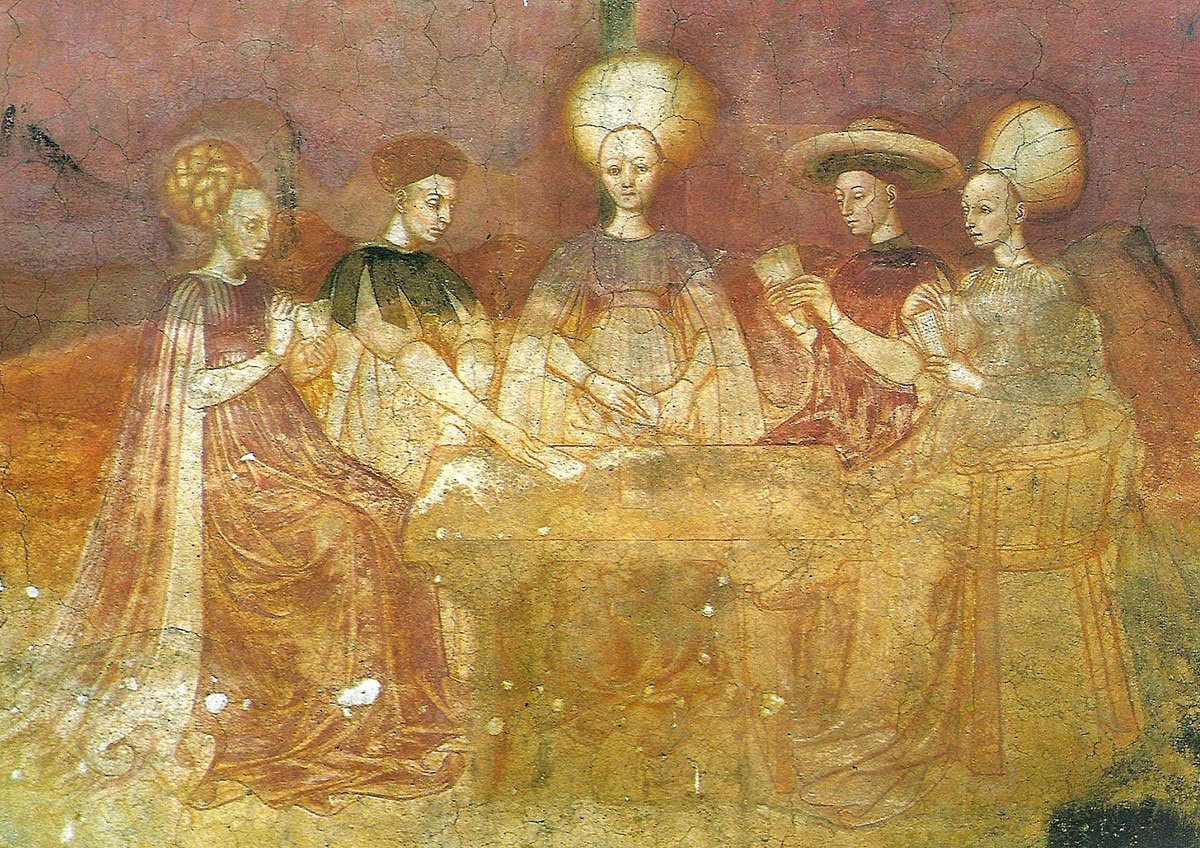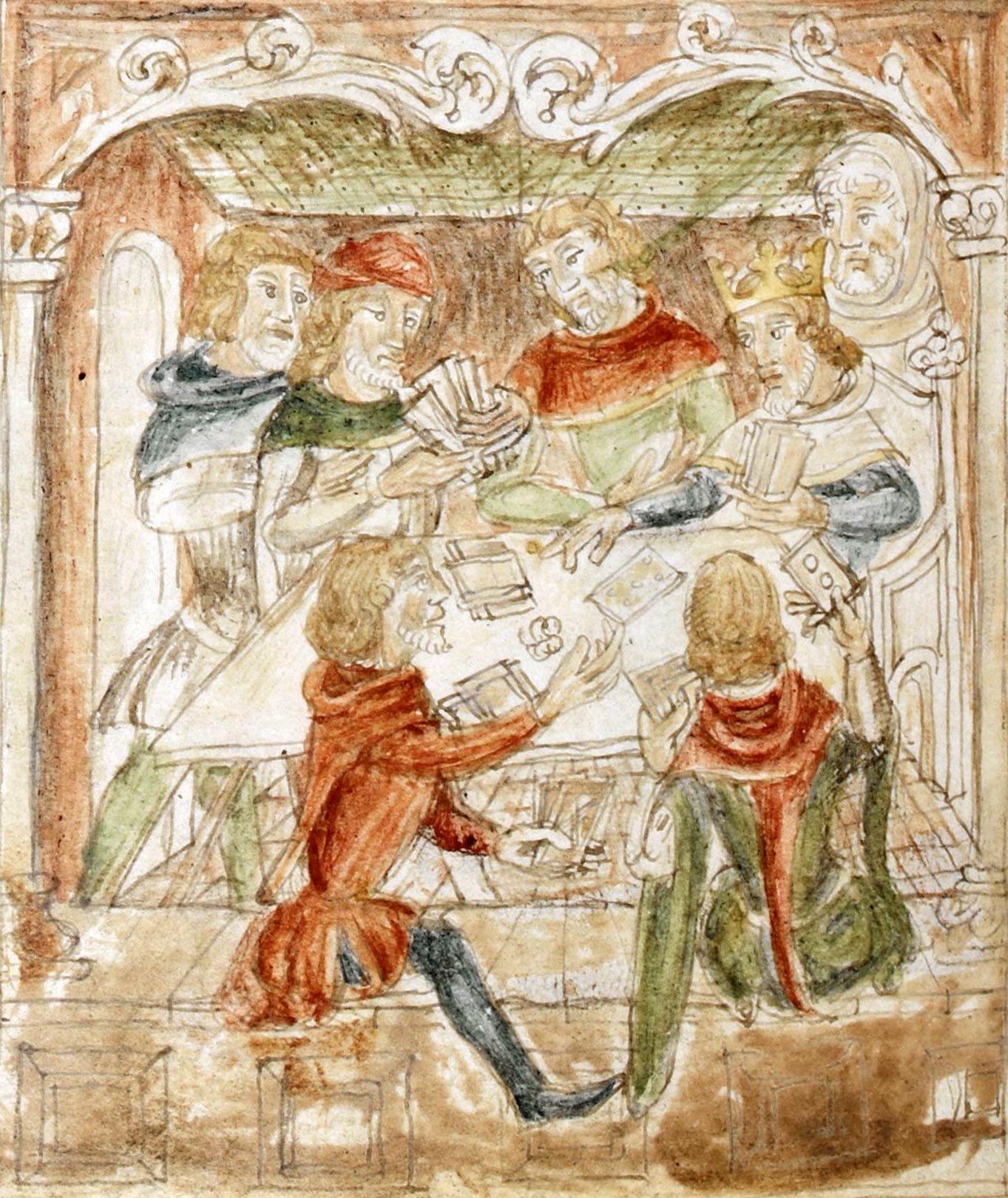

| 23-02-2017 (2842 ) | Categoria: Naips |
Playing Cards are believed to have originated in China and then spread to India and Persia. From Persia they are believed to have spread to Egypt during the era of Mamluk control, and from there into Europe through both the Italian and Iberian peninsulas during the second half of the 14th century. Thus, European playing cards appear to have an Islamic derivation. Some of the earliest surviving packs were hand painted works of art which were expensive and affordable only by wealthy patrons such as dukes or emperors.
But you can play card games with any old pack so as demand increased new, cheaper methods of production were discovered so that playing cards became available for everyone...
The history of playing cards in popular art is fascinating and has a long tradition. This section is an online tutorial covering the early history of playing cards. You will learn about the following topics:

Above: detail from âLa Sala de Las Batallasâ mural painting in El Escorial palace (Madrid) produced by a team of Italian artists, late 16th century (click to zoom).
At the end there will be a quiz to consolidate your knowledge.

Above: the Tarocchi Players of Casa Borromeo, Milan 15th C.

Above: British Library manuscript Add MS 12228, date 1352-1362. This is the earliest known depiction of card play, a miniature in a 14th-century manuscript of Meliadus or Guiron le Courtois (part of the romance also known as Palamedes; also known as Le Roman du Roy Meliadus de Lennoys), by HĂŠlie de Boron. The manuscript was written with areas left blank for bas-de-page miniatures, like this one, to be added. Hundreds were added to this manuscript, at various times and by various artists, this one probably late 14th century. The present image shows King Meliadus and his followers amusing themselves while in captivity. Players are shown holding square-cornered cards fanned in their hands, hidden from view, and playing cards onto the table. They are playing a 4-handed trick-taking game, following suit, and piling tricks cross-wise for ease of counting. The deck uses the Latin suit-signs (coins and staves are shown), and the game is being played for money or counters, shown on the table. Card playing is not mentioned in the text but there is mention of the imprisoned men entertaining themselves. Apparently the artist simply imagined the scene as involving the newly introduced and highly portable game of cards. Source: British Library Add MS 12228âş
REFERENCES
Pratesi, Franco: on the history of playing cards and card games, Â Online hereâş
Cardboard consists of a number of thicknesses of paper pasted together, pressed and polished on two surfaces. Ordinary cardboard consists of two sheets of white paper with a sheet of cartridge paper between them, and the thickness of the board is determined by the stoutness of the paper. For stout cards two or more sheets of cartridge paper are interposed. Modern playing-card board is usually laminated with a black adhesive and comes in a range of weights and with matt, glazed or embossed finishes including âlinen grainâ or âair cushionâ finish. The following notes describe the manufacture of cardboard in the nineteenth century.

Above: close-up view of the edges of two packs of playing cards. The left-hand cards are manufactured around 1880, the right-hand cards are from c.1990. In both cases the 3-ply composition of the cardboard is discernible, with a thick, opaque layer inside two surface papers. This prevents the cards from being transparent and also gives the necessary strength and firmness to be used for play.
Consider the manufacture of three-sheet card. The arranging of the paper for this is called mingling. That is, a ream of white demy paper is spread open, and between every two sheets one sheet of cartridge paper is placed; and the pile when complete is called a head, consisting, of course, of a ream and a half of paper.

Above: the freshly pasted card is pressed. The press itself was probably inspired by wine presses in the late 14th century. Â See also: History of Playing Cards.
The next process is pasting. A man stands at a bench with a mahogany slab before him, the head of paper on his left hand and a large tub of paste on his right. Pulling the first sheet from the head upon the mahogany slab with his left hand, the paster with his large brush saturated with thin smooth paste covers it with a layer by two or three skilful movements of the arm and hand. He then pulls down upon this pasted surface a sheet of cartridge paper, the top surface of which is in like manner pasted. He next pulls down upon the pasted cartridge surface two sheets of white paper, and covers the upper surface only with paste. One sheet of cartridge paper is pulled down upon this and pasted; then two sheets of white paper, and so on until the whole head has been pasted. Now it is obvious that by pulling down two sheets of white paper with no paste between them the boundary between two sheets of cardboard is made.
One man will paste 4 heads of paper, or 7 gross of cardboards in one day. This will consume about 14 lbs or 16 lbs of flour, reckoning 1 lb of flour equal to one gallon of paste. In some cases it helps to dampen the paper beforehand.
When the head has been pasted, it is put into an upright press, and condensed by the action of a well-oiled iron screw and a long lever worked by two men. The water of the paste oozes out at the edges of the head, and falling into a channel in the lower bed of the press, escapes through a hole into a bucket, which becomes entirely filled with clear water from the produce of one man's work in the course of one day.

Above: interior view of playing card workshop drying area. The freshly pasted sheets of cardboard are prepared for hanging up to dry on wires. After a certain time the sheets of cardboard were removed from the press, brushed to remove any dirt and then pierced with a spike so that they could be hung up on wires in the drying rooms. These areas were well ventilated rooms at the top of the building. The dried cardboard was then stored. Illustration from L'Encyclopedie by Diderot, d'Alembert, Paris, 1751.

The next process is drying. Every evening before the men leave off work, each man takes out of the press the heads which he has pasted during the day and hangs the cardboard pieces on lines to dry. This involves piercing the corner of each sheet and passing a 1½" length of thin copper wire through the hole which then serves to hook the piece to the drying lines. The room is artificially heated, and in the course of twenty-four hours, that is, on the next evening when the lines are wanted for the next day's work, the boards are sufficiently dry. Then they are separately brushed with a hair brush to remove any dust &c.
Right: âPaper Productionâ, a woodcut illustration by Jost Amman from The Book of Trades (Das Ständebuch), 1568. The manufacture of paper in Europe began in Spain during the 11th century but it had been used at least as early as the eighth century by the Chinese and Arabs. Spain, therefore, was the channel by which paper spread into Europe several centuries before it began to be used for the manufacture of playing cards. The art of printing gave a great boost to the paper making industries and brought about a scarcity of old rags, until the technology for making wood pulp was improved.
The boards are now rough on the surface, warped and uneven. They are made smooth and even by passing them between a couple of powerful iron rollers in contact with thin sheets of smooth copper plate. The rough uneven cardboard is converted into a perfectly even board with a beautifully polished glazed surface. Several boys are employed taking out sheets of cardboard and arranging them into heaps.
The cards are now ready to be formed into playing cards... as a final cautionary remark, researchers have found that toxic chemicals from recycled newspapers had contaminated food sold in many cardboard cartons. The chemicals, known as mineral oils, come from printing inks!
Afegeix-hi un comentari: